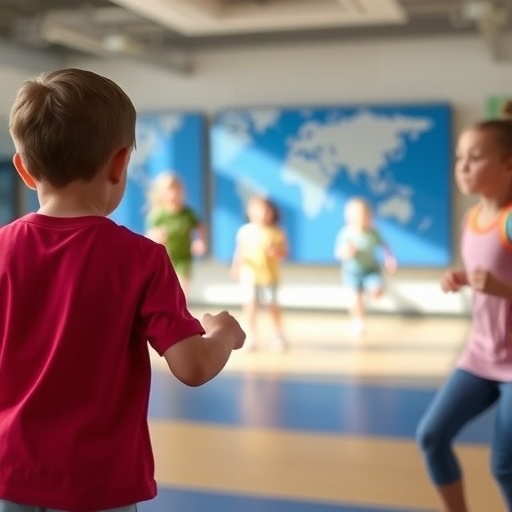In recent years, there has been a growing awareness of the importance of facilitating physical activity among autistic children and youth. The recent scoping review conducted by Michaud and Harvey underscores this necessity, providing a comprehensive analysis of the current landscape surrounding active participation for this demographic. The authors dive deep into the significance of physical activity as a critical component of overall health and well-being for autistic individuals, highlighting the unique challenges they face in engaging in physical activities.
Physical activity serves as an essential pathway for improving physical health and mental well-being for all children, including those on the autism spectrum. The review posits that beyond the benefits of physical fitness, active participation facilitates social skills, emotional regulation, and general quality of life. However, many autistic children encounter substantial barriers to engaging in these activities. Michaud and Harvey’s work aims to spotlight these barriers and explore ways to dismantle them, promoting an inclusive approach to physical activity.
The authors also examine the various environmental, social, and personal factors that impact physical activity participation. Environmental factors may include the availability of suitable facilities, accessibility of transportation, and the presence of supportive peers. These elements can significantly affect the opportunities for autistic youth to participate in physical activities, intricately tied to both personal preferences and social acceptability. Understanding these dynamics is crucial for creating an environment where participation is not just possible but encouraged.
Furthermore, the scoping review highlights the role of educators, therapists, and family members in facilitating engagement. The interplay between these figures can create a more supportive network that enhances the likelihood of sustained physical activity. Collaboration among these stakeholders is vital, as they can provide the emotional and practical support needed to navigate the complexities that autistic children may face. Michaud and Harvey advocate for a coordinated effort to cultivate opportunities tailored to individual needs and preferences.
The social aspects of engaging in physical activity cannot be overlooked, as they contribute significantly to the holistic development of autistic children. Participation in team sports, group activities, or even individual pursuits can foster connections with peers, build friendships, and develop crucial social skills. The review highlights empirical evidence suggesting that inclusion in such activities results in improved self-esteem and reduces feelings of isolation, positively impacting emotional well-being.
In addition to social benefits, the physiological advantages of physical activity cannot be understated. Regular engagement in exercise can lead to enhanced motor skills, coordination, and overall physical health. For autistic individuals, these benefits are particularly significant, given the spectrum of physical challenges and differences they may experience. By emphasizing the importance of tailored physical activity that caters to individual abilities, the research promotes a message of hope and empowerment.
In navigating potential challenges, including sensory sensitivities and varying levels of motivation, the authors provide insights into evidence-based practices that can increase participation rates. Creating adaptive programs, offering sensory-friendly environments, and utilizing technology to engage youth are just a few strategies that can make physical activity more accessible. These tailored approaches help to foster a sense of achievement and motivation among autistic children, reinforcing the value of physical engagement in their lives.
As the authors delve into the implications of their findings, they underscore the need for continued research and policy changes that prioritize the physical activity needs of autistic youth. There is a clarion call for policymakers to recognize the importance of inclusive physical activity programs in schools, community centers, and recreational facilities. Advocacy efforts must align to ensure that resources are allocated to develop and sustain such initiatives effectively.
The review culminates in a robust discussion around the future of physical activity participation for autistic children. Michaud and Harvey envision a world where all children, regardless of their neurodevelopmental profiles, can thrive in active environments. Their research contributes valuable knowledge that can influence practice, promote inclusive programming, and ultimately improve the health outcomes for autistic youth.
To sum up, the scoping review serves as a significant contribution to the existing literature on autism and physical activity, creating a foundation for future studies, community projects, and educational frameworks. By shining a spotlight on the barriers while simultaneously illuminating potential solutions, Michaud and Harvey have crafted a resource that is not only informative but also actionable.
The road ahead is paved with challenges, yet it is also filled with opportunities for growth and engagement. As awareness spreads and research continues to evolve, the dialogue around facilitating physical activity for autistic children gains momentum. Communities, educators, and caregivers stand to benefit from this expanding knowledge base as they collaborate to foster environments where every child can flourish physically and socially through active participation.
In this pivotal moment, it is imperative that all stakeholders recognize their role in shaping a supportive atmosphere for autistic children and youth. By working together to break down barriers and promote access, we can ensure that the joys and benefits of physical activity reach every corner of our diverse society.
Subject of Research: Facilitating Physical Activity Participation Among Autistic Children and Youth
Article Title: Facilitating Physical Activity Participation Among Autistic Children and Youth: A Scoping Review
Article References: Michaud, M., Harvey, W. Facilitating Physical Activity Participation Among Autistic Children and Youth: A Scoping Review. J Autism Dev Disord (2025). https://doi.org/10.1007/s10803-025-07141-y
Image Credits: AI Generated
DOI: https://doi.org/10.1007/s10803-025-07141-y
Keywords: Autism, Physical Activity, Participation, Children, Scoping Review, Inclusive Activity, Motor Skills, Dimensions of Health.




